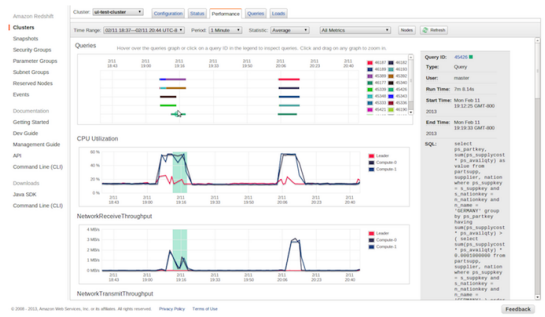Amazon’s Redshift Reaches General Availability
Amazon’s Redshift data-warehousing service has moved out of limited preview to general availability. That means any Amazon Web Services (AWS) customer can use Redshift to warehouse petabytes of data, using the AWS Management Console to provision and customize clusters as necessary. Amazon designed the service to operate at a fraction of the cost of on-premises data warehouses, as well as integrate with other services such as Amazon S3 and Amazon DynamoDB. Redshift is based out of the online giant’s US East (Northern Virginia) data center, although Amazon suggested in a Feb. 15 blog posting that it would expand to other AWS regions in “coming months.” Redshift users can start off with a single 2TB XL node and scale all the way up to 16TB 8XL nodes, good for 1.6 petabytes of compressed user data. On-demand pricing for the 2TB warehouse starts at $0.85 an hour, although Amazon has suggested that reserved-instance pricing lowers that cost to an “effective price” of $0.228 per hour; all told, Amazon claims that the total costs associated with Redshift are under $1,000 per terabyte per year. “Amazon Redshift nodes come in two sizes, the hs1.xlarge and hs1.8xlarge, which hold 2 TB and 16 TB of compressed data, respectively,” read a posting on the Amazon Web Services Blog when Redshift was first announced last fall. “An Amazon Redshift cluster can have up to 32 hs1.xlarge nodes for up to 64 TB of storage or 100 hs1.8xlarge nodes for up to 1.6 PB of storage. We currently set a maximum cluster size of 40 nodes (640 TB of storage) by default.” Redshift also offers automated monitoring of system resources—practically a perquisite for any Platform-as-a-Service (PaaS) or Infrastructure-as-a-Service (IaaS) option on the market today. That monitoring alerts IT administrators to ongoing issues. In terms of security, Redshift supports SSL for data in transit and hardware-accelerated AES-256 encryption for data at rest; administrators can also configure firewall rules for controlling network access to the warehouse cluster. Those with additional security concerns can run Redshift within an Amazon Virtual Private Cloud (VPC) to isolate the warehouse cluster still further. AWS remains an aggressive marketplace player; over the past several months, Amazon has done everything from revamp the AWS Data Pipeline to issue a number of new instance families. That could give AWS an advantage as it faces heightened cloud competition from the likes of Oracle and Microsoft, although there have been questions about the platform’s growth and profitability. Image: Amazon


